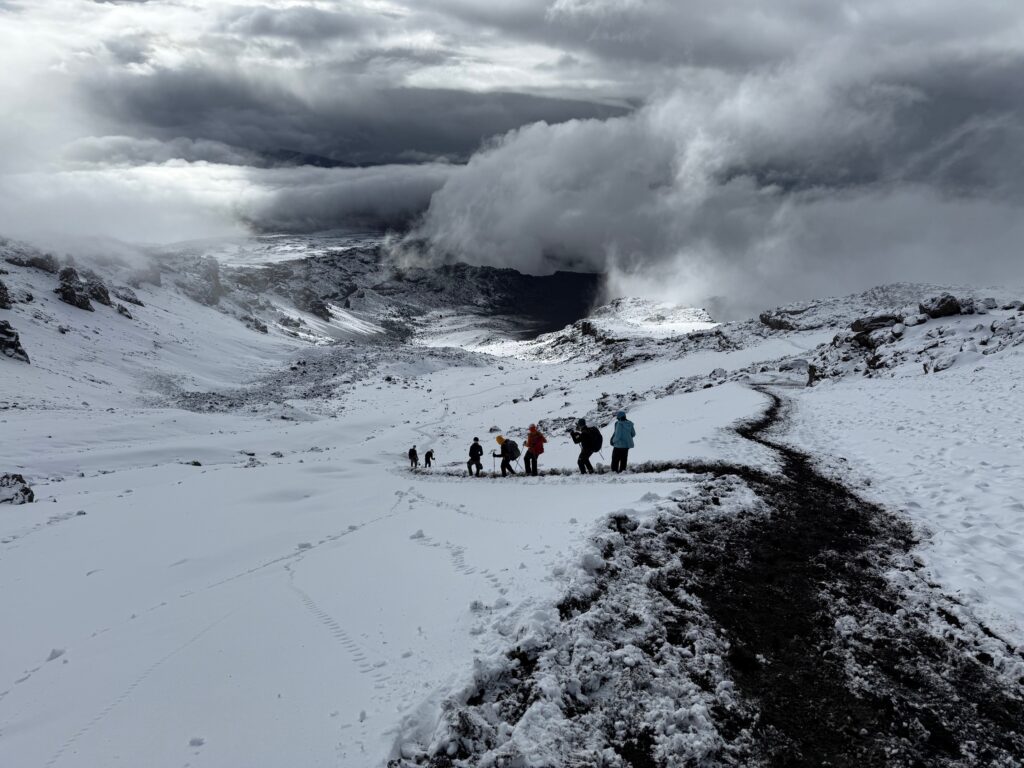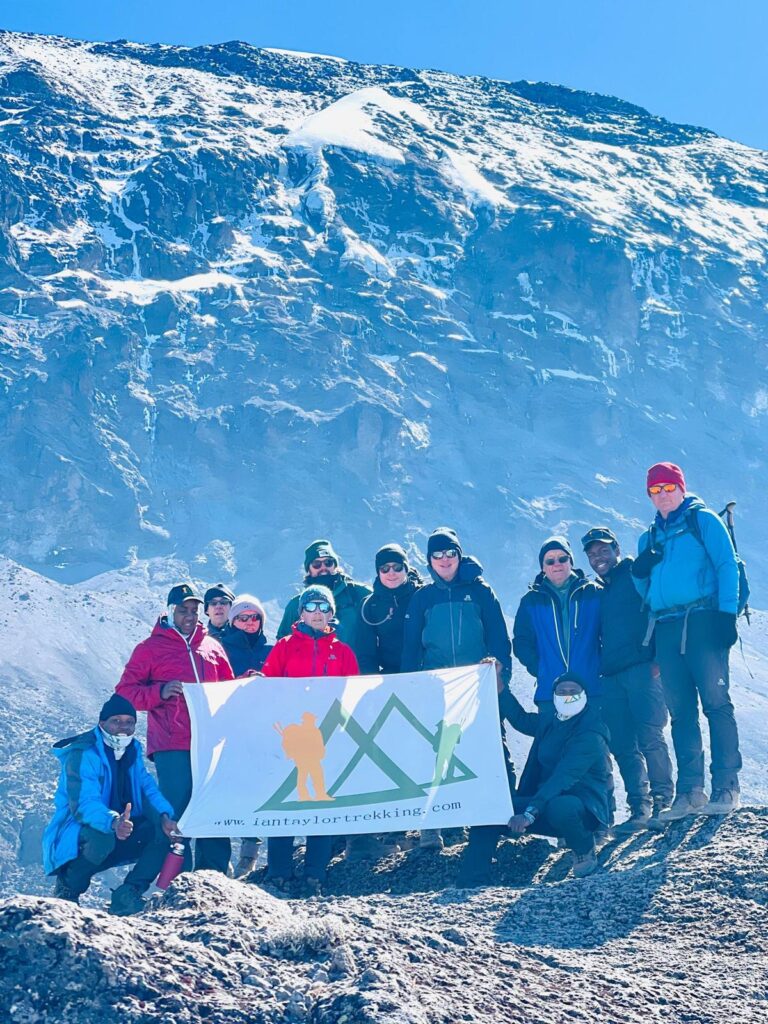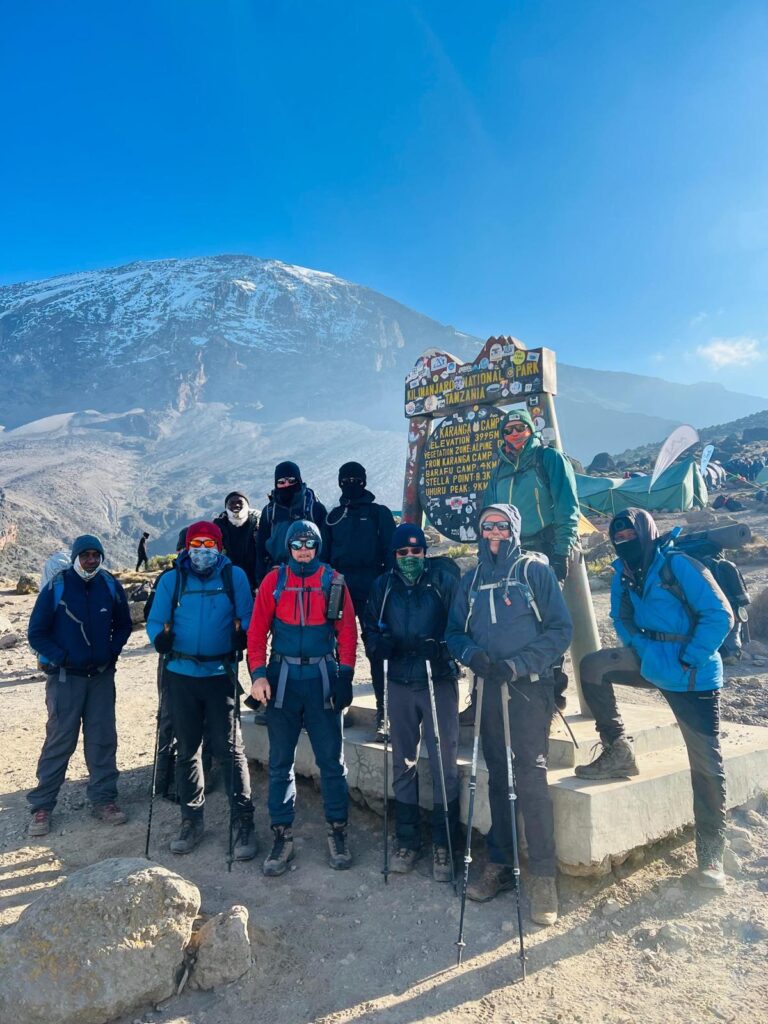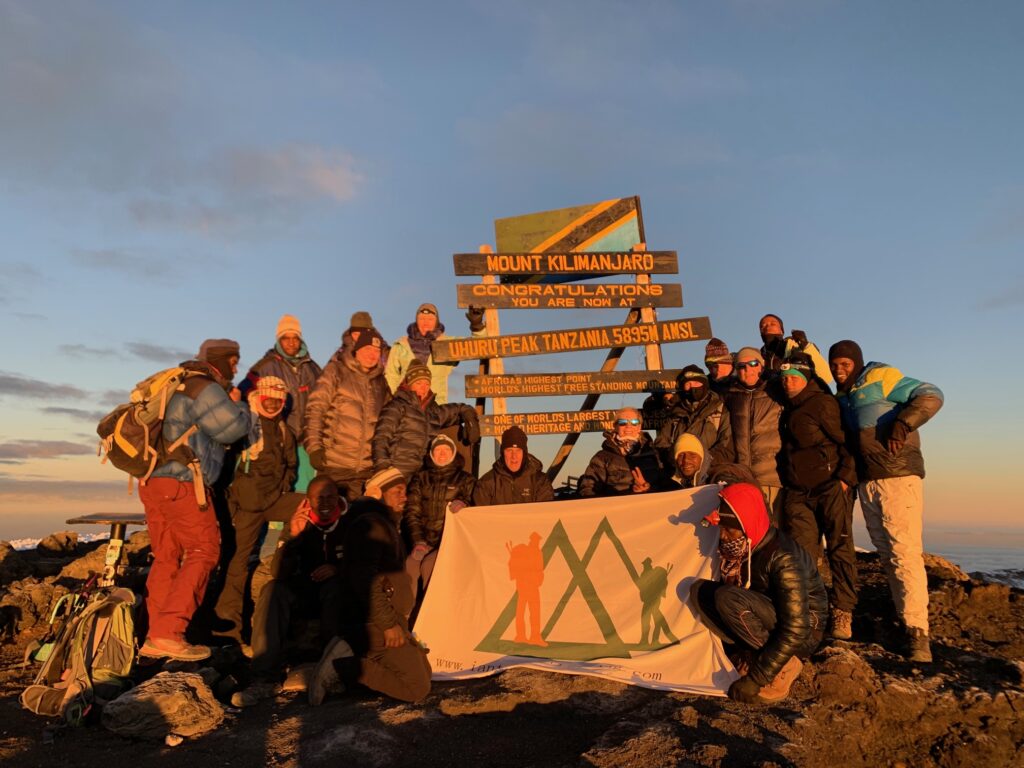Climbing Kilimanjaro is unlike any other trek in the world. At 5,895 meters (19,341 feet), Africa’s highest peak takes you from lush, equatorial rainforest to the icy, windblown arctic summit in less than a week. That means you’ll experience a journey through four distinct climate zones, each with its own challenges.
At Ian Taylor Trekking, our office team has climbed Kilimanjaro over 55 times, and we know exactly how the temperatures shift on the mountain—and how to prepare you for success. Here’s everything you need to know about Kilimanjaro’s temperatures, rainfall, and what to wear at every stage of your climb.

Low Oxygen and the Sensation of Feeling Cold
As you climb higher, oxygen levels drop dramatically. At the summit, oxygen is less than 50% of what it is at sea level. With reduced oxygen, your body struggles to generate heat efficiently, making you feel colder than the actual air temperature.
This is why many climbers report feeling chilled even when the thermometer shows just below freezing. Add wind to the mix, and the perceived temperature can be 10–15°C colder than the actual reading. Our guides carefully pace the climb to protect against overexertion and help you conserve heat, while advising you on when to layer up for maximum comfort.
Kilimanjaro Temperatures by Elevation Zone
| Zone | Elevation | Daytime Temps | Nighttime Temps | Conditions |
| Rainforest | 1,800–3,000 m (5,900–9,800 ft) | 15–27°C (60–80°F) | 7–12°C (44–54°F) | Warm, humid, frequent rain |
| Heather & Moorland | 3,000–4,000 m (9,800–13,100 ft) | 10–20°C (50–68°F) | 0–5°C (32–41°F) | Chilly nights, open exposure |
| Alpine Desert | 4,000–5,000 m (13,100–16,400 ft) | -2 to 18°C (28–65°F) | -7 to 3°C (20–37°F) | Intense sun, rapid swings |
| Arctic / Summit | 5,000–5,895 m (16,400–19,341 ft) | -7 to 5°C (20–40°F) | -7 to -20°C (20 to -4°F, colder with windchill) | Harsh winds, icy terrain |
The Impact of Wind on Temperature
I have been high on Kilimanjaro when the temperature was -23°C -10°F. On Kilimanjaro, wind is the true game-changer. A calm night at high camp can feel manageable, but when 40–50 km/h (25–30 mph) winds sweep across the slopes, the windchill can make it feel 20°C colder.
That’s why Ian Taylor Trekking provides you with a detailed Kilimanjaro gear list in our 40 page trip dossier. We can also advice you personal advice on layering. A proper down jacket and windproof outer shell is not optional—they are essential for summit night.

Temperatures in the Rainforest Zone
The rainforest is the warmest and wettest part of your climb. With 2,000–3,000 mm (80–120 inches) of rainfall annually, you can expect humid days (15–27°C / 60–80°F) and cooler, damp nights (7–12°C / 44–54°F).
This is where many climbers make their first mistakes—packing cotton or non-quick-dry clothing. Cotton holds moisture, leaving you cold and clammy by evening. We recommend light, moisture-wicking clothing, merino woold is best and reliable rain protection to stay comfortable.
How Altitude Affects Temperature
A useful rule of thumb: for every 300 meters (1,000 feet) you climb, the temperature drops about 2°C (3.5°F). That means while the base of Kilimanjaro might feel tropical at 25°C (77°F), the summit can plunge to -20°C (-4°F) or colder, especially before dawn.
Our team prepares you for this reality, reminding clients that the coldest time is summit night, just before sunrise, when oxygen is lowest and winds are strongest. Read about our approach to summit night on Kilimanjaro.

What to Wear on Kilimanjaro: From Rainforest to Summit
Climbing Kilimanjaro is all about smart layering. You’ll pass through everything from humid jungle to freezing arctic conditions in a matter of days. Here’s our expert clothing advice:
Rainforest (1,800–3,000 m / 5,900–9,800 ft)
Lightweight moisture-wicking tops. Merino wool T-shirts or long sleeve hoody to protect your arms and neck from the sun.
Trekking pants or shorts. Whatever you are more comfortable wearing.
Waterproof jacket. We prefer a Gore-Tex shell jacket as you will potentially need this on the summit night to block wind.
Sun hat for hot stretches. You can wear a brimmed hat or baseball cap with sun hoody.
Pro Tip: Avoid cotton—it traps moisture.
Heather & Moorland (3,000–4,000 m / 9,800–13,100 ft)
Sun hoody – Merino T-shirt (synthetic/merino)
Down vest. I personally like the Patagonia down vest.
Fleece, light down jacket or synthetic. I always bring my Patagonia nano jacket.
Convertible trekking pants. This is a good option is it is cold in the morning and then warms up quickly.
Light gloves and warm hat
Pro Tip: Be ready to adjust layers quickly as mornings are cold but afternoons warm.
Alpine Desert (4,000–5,000 m / 13,100–16,400 ft)
Thermal base layers. These are generally not be needed while hike to Lava Tower, Karanga or hiking up to Kosovo Camp.
Warm fleece jacket. These days I never wear a synthetic jacket like the Patagonia nano jacket. It is much lighter.
Down jacket. Not a bad thing to have in your bag at this stage.
Windproof jacket. A Gore-Tex shell jacket and rain pant should be in your bag every day.
Sunglasses & sunscreen. All have these in your backpack.
Liner gloves. These can be used on the Lava tower, Barranco wall and going from Karanga Camp to Kosovo Camp.
Pro Tip: Always keep a warm layer handy—conditions can change in minutes.
Summit Zone (5,000–5,895 m / 16,400–19,341 ft)
On most summit attempts I start with thick merino wool base layer. Right on top of my base layer I wear a down vest followed by my Patagonia nano jacket. I normally start in these three layers. About 3 or 4 hours into the summit night I add my big down jacket followed by my Gore-Tex jacket if it gets extremely windy. I prefer to use a light wool hat with a buff. Balaclavas are not for me.
In addition I use a base layer merino bottom, with my trekking pants over the top of the merino base layer. Depending on the weight of your trekking pants you may need to use 3 layers on your legs. I use thicker trekking pants so I rarely need to use Gore-Tex pants over my wool base layer and trekking pants. Having options is the key here.
Heavy thermal base layers. I use Smartwool merino 260 top and bottom.
Down vest, thick mid layer and down jacket
Insulated pants + shell
buff + liner gloves/mittens
Wool socks + insulated boots
Pro Tip: Dress in layers you can add/remove. You’ll warm up moving uphill but cool rapidly when resting.

Summit Temperatures on Kilimanjaro
At Uhuru Peak, you’ll face arctic conditions. Just remember after reaching the summit and when you drop down below stella Point 5,756m (18,885 ft) the temperature will slow continue to rise. The more the sun comes up the warmer it will get. We like to drop down below 5,500m (18,044 ft) as quickly as possible and take a few rest breaks before getting back to Kosovo Camp 4,900m (16,076 ft). We normally rest, pack up and eat before dropping lower on the mountain. You can face the following conditions:
Daytime (clear, little wind): -7°C to -1°C (19–30°F)
Nighttime / pre-dawn (summit push): -7°C to -20°C (19 to -4°F), colder with windchill
Windchill factor: Feels as cold as -25°C (-13°F) or lower on exposed ridges
The coldest hours are just before sunrise—exactly when you’ll be pushing for the summit. Once the sun rises, temperatures rise dramatically, offering an incredible moment of relief and reward.
Rainfall on Kilimanjaro
Kilimanjaro doesn’t follow the traditional four seasons. Instead, it has wet and dry cycles. You can read more about the best months for climbing Kilimanjaro in this post.
Long Rains (March–May): Heavy rainfall, cloud cover, muddy trails
Short Rains (November): Lighter showers, often in afternoons
Driest Months: January–February and June–October (best trekking windows)

Rainfall Varies by Climatic Zone:
Rainforest: 2,000–3,000 mm (80–120 in) annually
Moorland: 1,000–1,500 mm (40–60 in)
Alpine Desert: 200–400 mm (8–16 in)
Summit: <100 mm (4 in), mostly snow/ice
Final Thoughts from Ian Taylor Trekking
Climbing Mount Kilimanjaro is often described as trekking through four distinct climate zones in just one expedition. Within less than a week, trekkers move from the hot and humid Kilimanjaro rainforest, through the cooler moorland and heath zone, into the dry and barren alpine desert, and finally up to the freezing, oxygen-starved arctic summit zone at 5,895m (19,341 ft).
This rapid shift in landscapes and weather patterns is what makes climbing Kilimanjaro so unique—and why it’s essential to pack the right gear for both tropical heat and sub-zero temperatures.
Kilimanjaro: Award Winning Team
Our job at Ian Taylor Trekking is to make sure you’re fully prepared with the right gear, layering system, and pace strategy. By understanding the temperatures and rainfall patterns, and by training properly beforehand, you’ll not only increase your chances of standing on the Roof of Africa but also make the journey safer and far more enjoyable.

Kilimanjaro Experts!
At Ian Taylor Trekking, we know that climbing Kilimanjaro isn’t just about reaching the summit—it’s about doing it safely, comfortably, and with the right support team behind you. With over 45 successful personal climbs and a dedicated team of expert guides with over 2,000 summits, we focus on the details that make the difference: proper pacing, high guide-to-client ratios, better meals, superior tents, and more personal attention on and off the mountain.
When you climb Kilimanjaro with us, you’re not just joining a trek—you’re joining a team that is committed to your safety, success, and lifelong memories. We also support our staff and local community. If you want the best chance of standing on the Roof of Africa while experiencing the mountain the right way, choose Ian Taylor Trekking.
